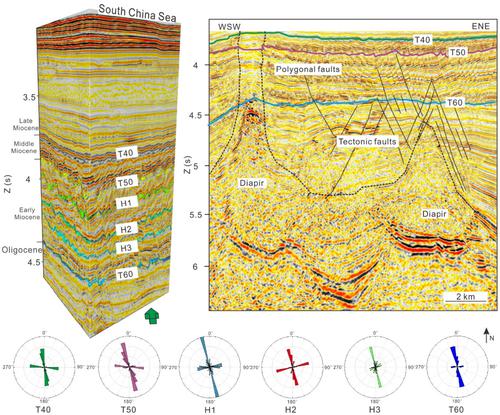当前位置:
X-MOL 学术
›
Basin Res.
›
论文详情
Our official English website, www.x-mol.net, welcomes your
feedback! (Note: you will need to create a separate account there.)
Geometry and evolution of polygonal fault systems under a regionally anisotropic stress field: Insights from 3D seismic analysis of the Qiongdongnan Basin, NW South China Sea
Basin Research ( IF 2.8 ) Pub Date : 2024-02-24 , DOI: 10.1111/bre.12855 Shouxiang Hu 1, 2 , Alte Rotevatn 3 , Christopher Jackson 4 , Wei Li 1, 2 , Xiaochuan Wu 5, 6
Basin Research ( IF 2.8 ) Pub Date : 2024-02-24 , DOI: 10.1111/bre.12855 Shouxiang Hu 1, 2 , Alte Rotevatn 3 , Christopher Jackson 4 , Wei Li 1, 2 , Xiaochuan Wu 5, 6
Affiliation

|
Polygonal fault systems (PFS) are developed in many sedimentary basins, and their formation, growth, and ultimate geometry have been widely studied. The geometry and growth of PFS forming under the influence of regionally anisotropic stresses, however, are poorly understood, despite the fact these structures may serve as key paleo‐stress indicators that can help reconstruct the tectonic and stress history of their host basins. We here use high‐quality 3D seismic reflection data and quantitative fault analysis to determine the geometry and evolution of a PFS in the Qiongdongnan Basin (NW South China Sea), and its possible relationship with the geological and stress history of the basin. The PFS is dominated by two intersecting NNW‐to‐N‐ and E‐striking fault sets, which initiated in the Early Miocene. The dominant fault strike at the structural level at which the faults nucleated and where strain is greatest (i.e., Lower Miocene) is close to NW–SE. However, at the top and bottom of the PFS tier faults strike NNW–SSE, thereby defining a very slight vertical, clockwise rotation of strike. Based on the observation that the host rock is flat‐lying, it is unlikely that basin‐tilting perturbed (i.e., δ2 ≠ δ3) the otherwise radially isotropic stress field that typically characterize PFS. Likewise, diapirs that punctuate the host rock and that are spatially related to the PFS appear not to control fault geometry. We instead infer that the PFS geometry reflects a combination of local isotropic and regional, extension‐related tectonics stress affecting the Qiongdongnan Basin during the Early Oligocene to Middle Miocene. Regional studies suggest that during this time, extensional stresses in eastern Qiongdongnan Basin rotated clockwise from roughly NNW to N; we noticed the rotation of strike of the PFS, within which the vertical change in fault strike being relatively minor. Our study determines the timing of polygonal fault growth within the Qiongdongnan Basin and the associated geometry, highlighting the key role played by regional and local stresses.
中文翻译:

区域各向异性应力场下多边形断层系统的几何形状和演化:南海西北琼东南盆地三维地震分析的见解
多边形断层系统(PFS)在许多沉积盆地中发育,其形成、生长和最终几何形状已得到广泛研究。然而,人们对在区域各向异性应力影响下形成的 PFS 的几何形状和生长知之甚少,尽管这些结构可能作为关键的古应力指标,有助于重建其所在盆地的构造和应力历史。我们使用高质量的3D地震反射数据和定量断层分析来确定琼东南盆地(南海西北部)PFS的几何形状和演化,及其与盆地地质和应力历史的可能关系。PFS 主要由两个相交的 NNW 至 N 和 E 走向断层组主导,这些断层组起始于早中新世。断层成核且应变最大(即下中新统)的构造层面上的主要断层走向接近西北-东南方向。然而,在 PFS 层断层的顶部和底部,走向 NNW-SSE,从而定义了一个非常轻微的垂直顺时针旋转。根据对围岩平坦的观察,盆地倾斜不太可能扰动(即 δ2 ≠ δ3)通常表征 PFS 的其他径向各向同性应力场。同样,贯穿主岩且在空间上与 PFS 相关的底辟似乎并不控制断层几何形状。相反,我们推断PFS几何形状反映了早渐新世至中中新世期间影响琼东南盆地的局部各向同性和区域性、伸展相关的构造应力的组合。区域研究表明,在此期间,琼东南盆地东部的拉应力大致从北北西向北顺时针旋转;我们注意到PFS走向的旋转,其中断层走向的垂直变化相对较小。我们的研究确定了琼东南盆地内多边形断层生长的时间和相关的几何形状,强调了区域和局部应力所发挥的关键作用。
更新日期:2024-02-24
中文翻译:

区域各向异性应力场下多边形断层系统的几何形状和演化:南海西北琼东南盆地三维地震分析的见解
多边形断层系统(PFS)在许多沉积盆地中发育,其形成、生长和最终几何形状已得到广泛研究。然而,人们对在区域各向异性应力影响下形成的 PFS 的几何形状和生长知之甚少,尽管这些结构可能作为关键的古应力指标,有助于重建其所在盆地的构造和应力历史。我们使用高质量的3D地震反射数据和定量断层分析来确定琼东南盆地(南海西北部)PFS的几何形状和演化,及其与盆地地质和应力历史的可能关系。PFS 主要由两个相交的 NNW 至 N 和 E 走向断层组主导,这些断层组起始于早中新世。断层成核且应变最大(即下中新统)的构造层面上的主要断层走向接近西北-东南方向。然而,在 PFS 层断层的顶部和底部,走向 NNW-SSE,从而定义了一个非常轻微的垂直顺时针旋转。根据对围岩平坦的观察,盆地倾斜不太可能扰动(即 δ2 ≠ δ3)通常表征 PFS 的其他径向各向同性应力场。同样,贯穿主岩且在空间上与 PFS 相关的底辟似乎并不控制断层几何形状。相反,我们推断PFS几何形状反映了早渐新世至中中新世期间影响琼东南盆地的局部各向同性和区域性、伸展相关的构造应力的组合。区域研究表明,在此期间,琼东南盆地东部的拉应力大致从北北西向北顺时针旋转;我们注意到PFS走向的旋转,其中断层走向的垂直变化相对较小。我们的研究确定了琼东南盆地内多边形断层生长的时间和相关的几何形状,强调了区域和局部应力所发挥的关键作用。






























 京公网安备 11010802027423号
京公网安备 11010802027423号